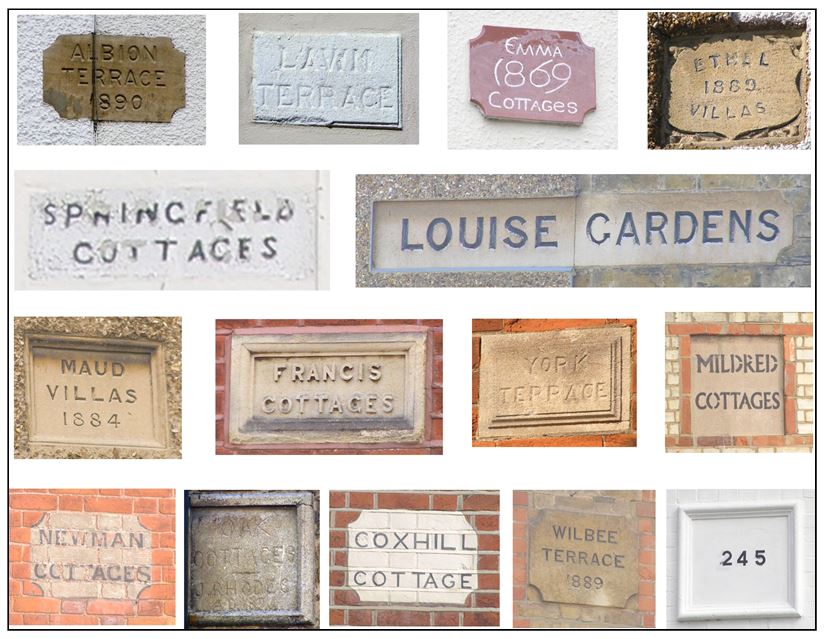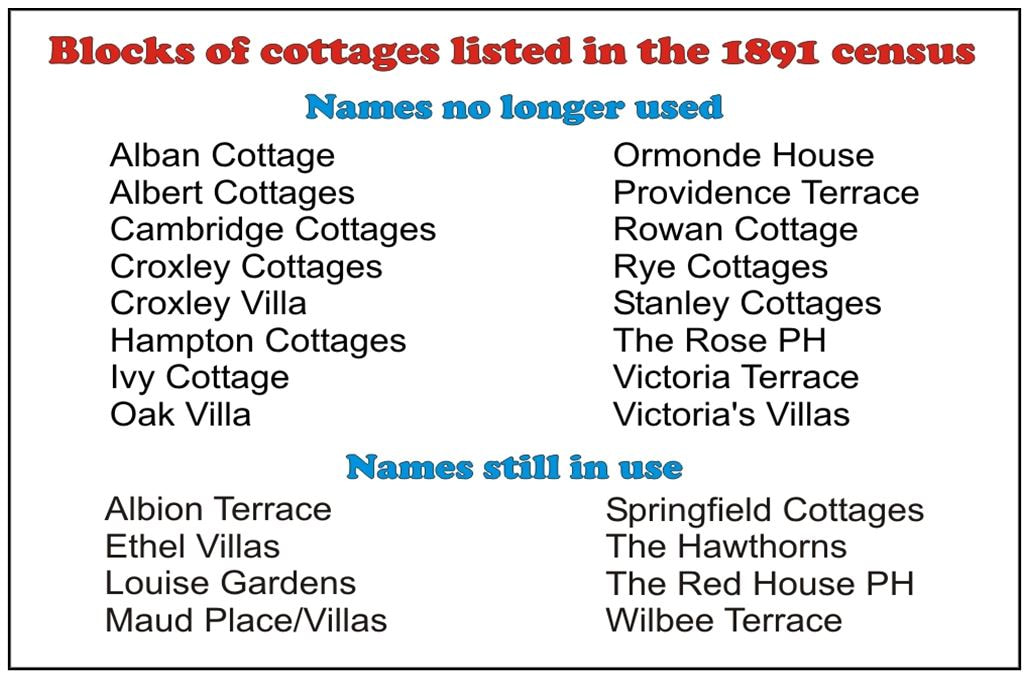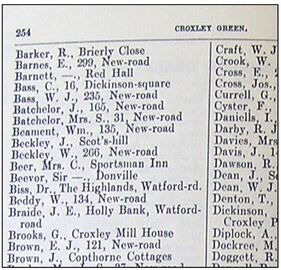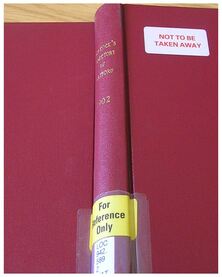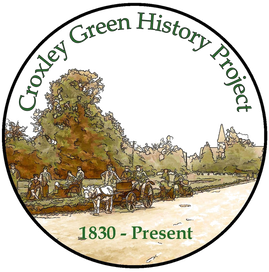A stroll down New Road - Census Interlude
Interlude - Information from the 1891 census and other sources
While we are getting our breath back from the walk along the North side, here is just a little background about some other sources of information we have used. We felt it would be interesting to try to find out more about who was living in the area at the time, what their jobs were etc. Although we have both had an input, Jim Hughes has tended to take the lead in this part of the project.
The 1891 census
As I have already mentioned way back in the introduction, Jim joined a web site which allowed him, for a fee, to download details of the 1891 census and he did this for the whole of Croxley Green. This has a wealth of information, which we have been very interested to sift through but it has one major disadvantage. In 1891 there were no house numbers in Croxley Green. They had been in use for some years in other areas, mostly the larger towns, but not, it appears, here! More about this a little later.
The general information which was gathered for each person was listed under the headings shown on the diagram below. The census taker would have gone through all of the information, gathering statistics on to separate tally sheets, since it was this and not individual information which was of use to central government and local councils. We have repeated this exercise to a degree with our own headings to get our own picture of the times.
While we are getting our breath back from the walk along the North side, here is just a little background about some other sources of information we have used. We felt it would be interesting to try to find out more about who was living in the area at the time, what their jobs were etc. Although we have both had an input, Jim Hughes has tended to take the lead in this part of the project.
The 1891 census
As I have already mentioned way back in the introduction, Jim joined a web site which allowed him, for a fee, to download details of the 1891 census and he did this for the whole of Croxley Green. This has a wealth of information, which we have been very interested to sift through but it has one major disadvantage. In 1891 there were no house numbers in Croxley Green. They had been in use for some years in other areas, mostly the larger towns, but not, it appears, here! More about this a little later.
The general information which was gathered for each person was listed under the headings shown on the diagram below. The census taker would have gone through all of the information, gathering statistics on to separate tally sheets, since it was this and not individual information which was of use to central government and local councils. We have repeated this exercise to a degree with our own headings to get our own picture of the times.
The extract above shows the headings used in the census ledger. Having gained the raw information from each individual property the results were then written up under these headings. Until 1911 the Enumerator called at each house and took the details of who was living in the property on that day. Whoever spoke to the enumerator would not always know the exact information about the residents, and may even have been a visitor. Hence there are often discrepancies as to names, dates and places of birth. In 1911 the Head of the household filled it in and signed it.
The headings are, I think, pretty self-explanatory. The “No. of Schedule” in the first column was merely a consecutive number for each separate property – nothing to do with house numbers (as in this area they didn’t exist anyway!) but merely a way of counting the numbers of individual properties in each area.
For column 7, each family unit had to nominate a head – normally the husband in an average family - and the relationship of the “Head” to everyone else staying in the premises on the night of the census had to be made clear. Column 8 could be “M” for married, “S” for single, “W” for widowed or “D” for Divorced.
It is quite interesting to note from column 15 that, even in 1891, they were trying to track migration across the country – and column 16 is a question that we probably wouldn’t dare ask now – certainly not in those words anyway!
We thought that it would humanise our efforts a little more to try to find out who was living in each address, what their jobs were, size of families, etc. and the first problem, as I have already mentioned, was that houses had no consistent numbering. We decided, therefore, to try to relate each property on the census to a house number which is current today.
Two things have helped initially with this. First it appears that the census details were entered in the ledger methodically and in order – up one side and down the other. Secondly, when house numbers were finally introduced (round about 1901, we think, because they first appeared in the Peacock’s Directory in 1902) they very cleverly took account of the size of any plots which had not been developed and estimated the likely number of dwellings they might produce, leaving suitable gaps in the numbering.
This means that the road never seems to have needed re-numbering which makes identification of addresses very much easier. These pieces of information on their own were not enough, however. We needed more.
The headings are, I think, pretty self-explanatory. The “No. of Schedule” in the first column was merely a consecutive number for each separate property – nothing to do with house numbers (as in this area they didn’t exist anyway!) but merely a way of counting the numbers of individual properties in each area.
For column 7, each family unit had to nominate a head – normally the husband in an average family - and the relationship of the “Head” to everyone else staying in the premises on the night of the census had to be made clear. Column 8 could be “M” for married, “S” for single, “W” for widowed or “D” for Divorced.
It is quite interesting to note from column 15 that, even in 1891, they were trying to track migration across the country – and column 16 is a question that we probably wouldn’t dare ask now – certainly not in those words anyway!
We thought that it would humanise our efforts a little more to try to find out who was living in each address, what their jobs were, size of families, etc. and the first problem, as I have already mentioned, was that houses had no consistent numbering. We decided, therefore, to try to relate each property on the census to a house number which is current today.
Two things have helped initially with this. First it appears that the census details were entered in the ledger methodically and in order – up one side and down the other. Secondly, when house numbers were finally introduced (round about 1901, we think, because they first appeared in the Peacock’s Directory in 1902) they very cleverly took account of the size of any plots which had not been developed and estimated the likely number of dwellings they might produce, leaving suitable gaps in the numbering.
This means that the road never seems to have needed re-numbering which makes identification of addresses very much easier. These pieces of information on their own were not enough, however. We needed more.
House Names
Our next source of help was from the houses themselves – some of them are in named blocks, such as Louise Gardens. A number of blocks were named on the census of which a few still exist.
Again this gave us assistance in two ways. Firstly, obviously, blocks which were named in the census which still existed enabled us to pinpoint those addresses exactly.
Secondly, even if the names were no longer in use, the fact that a block of say five or six cottages could be identified at all meant that, by reference to the 1880 or 1898 Ordnance Survey maps, a lot more locations could be accurately pinpointed. Even more so if there were two blocks together, as happened in a few cases so, say a block of four cottages followed by a block of six could be accurately aligned on the map.
Our next source of help was from the houses themselves – some of them are in named blocks, such as Louise Gardens. A number of blocks were named on the census of which a few still exist.
Again this gave us assistance in two ways. Firstly, obviously, blocks which were named in the census which still existed enabled us to pinpoint those addresses exactly.
Secondly, even if the names were no longer in use, the fact that a block of say five or six cottages could be identified at all meant that, by reference to the 1880 or 1898 Ordnance Survey maps, a lot more locations could be accurately pinpointed. Even more so if there were two blocks together, as happened in a few cases so, say a block of four cottages followed by a block of six could be accurately aligned on the map.
By now we had a pretty good idea of who lived where, but there was still an amount of guesswork required. Some blocks of missing numbering could be filled in only one way and so there was no problem. Just a few places, however it was still not clear, so one more source of information was required.
The 1902 Peacock's Directory
Watford library has a set of Peacock’s Directories and a set of Kelly’s Directories which list all householders in the area for virtually every year from about 1880 until 1980’s, and with a bit of application, it is possible to trace fairly accurately the occupiers of every property at any time during this period.
Watford library has a set of Peacock’s Directories and a set of Kelly’s Directories which list all householders in the area for virtually every year from about 1880 until 1980’s, and with a bit of application, it is possible to trace fairly accurately the occupiers of every property at any time during this period.
A full list of names from the 1891 census and their relevant modern day addresses is attached as an appendix to this document. This has enabled us to quote with some degree of certainty about the ownership, occupation and size of family living in a number of properties during the course of this report.
Summary of census findings
And finally in this section, we return to the summary of the 1891 census to give a general picture of what the area, and this road in particular was like.
· There were 182 occupied premises along New Road with 3 unoccupied and 5 in the course of being built. (Another little nugget of information which has allowed us to give an exceptionally accurate date to the building of Louise Gardens – see later.)
· In these 182 cottages (I don’t actually know if there is a different definition of cottages or houses but it sounds more rural to say cottages!) lived 851 people – 436 male and 415 female. This gives an average house occupancy of about 4.7.
· 310 of these 851 were in paid employment – 251 males and 59 females. 12 were employers (i.e. running small businesses), the remaining 298 were employed by others.
· 31 (10%) were General Labourers – working on roads, building sites etc
· 29 were “Living on their own means” – meaning a pension, endowment or legacy etc.
· most (46%) were employed by Dickinson’s Paper Mills – 110 male and 31 female.
· 25 worked in some form of building trade – either as builders, bricklayers, carpenters, electricians, fitters, painters etc.
· 22 worked in farming - agricultural/farm labourers, dairymen, cowmen, shepherds, ploughmen and even one employed as a crow scarer.
· 20 were Domestic Servants of some sort – maids, servants, gardeners, grooms etc
· 49 were involved in what might loosely be termed “Service Industries” – 11 were shopkeepers, such as grocers, general dealers, butchers and an errand boy; 7 were bakers; 5 were blacksmiths; 7 were shoemakers, including one who called himself a “Boot Clicker” or designer and cutter of leather boots; 3 were boatmen, presumably from the Grand Union Canal and also an “Agent for a Canal Carrying Company”; a number of dressmakers, seamstresses, drapers, a milliner, and needlewomen; 4 printers; 3 carters; 4 publicans; 4 involved in laundry and 2 millers.
· sundry male occupations include watercress grower, tortoiseshell worker, clerk, cooper, “survey and inspector of nuisance”, hairdresser, platelayer on railway, policeman and fireman
· sundry female occupations include church caretaker, nurse and schoolmistress
Armed with all of this extra information we feel we were able to bring a little more life to the project than just old and sometimes forgotten names.
Since this work was done, the 1901 and 1911 censuses have become available and it would be excellent if someone could repeat Jim Hughes’ analysis of the information in them.
And finally in this section, we return to the summary of the 1891 census to give a general picture of what the area, and this road in particular was like.
· There were 182 occupied premises along New Road with 3 unoccupied and 5 in the course of being built. (Another little nugget of information which has allowed us to give an exceptionally accurate date to the building of Louise Gardens – see later.)
· In these 182 cottages (I don’t actually know if there is a different definition of cottages or houses but it sounds more rural to say cottages!) lived 851 people – 436 male and 415 female. This gives an average house occupancy of about 4.7.
· 310 of these 851 were in paid employment – 251 males and 59 females. 12 were employers (i.e. running small businesses), the remaining 298 were employed by others.
· 31 (10%) were General Labourers – working on roads, building sites etc
· 29 were “Living on their own means” – meaning a pension, endowment or legacy etc.
· most (46%) were employed by Dickinson’s Paper Mills – 110 male and 31 female.
· 25 worked in some form of building trade – either as builders, bricklayers, carpenters, electricians, fitters, painters etc.
· 22 worked in farming - agricultural/farm labourers, dairymen, cowmen, shepherds, ploughmen and even one employed as a crow scarer.
· 20 were Domestic Servants of some sort – maids, servants, gardeners, grooms etc
· 49 were involved in what might loosely be termed “Service Industries” – 11 were shopkeepers, such as grocers, general dealers, butchers and an errand boy; 7 were bakers; 5 were blacksmiths; 7 were shoemakers, including one who called himself a “Boot Clicker” or designer and cutter of leather boots; 3 were boatmen, presumably from the Grand Union Canal and also an “Agent for a Canal Carrying Company”; a number of dressmakers, seamstresses, drapers, a milliner, and needlewomen; 4 printers; 3 carters; 4 publicans; 4 involved in laundry and 2 millers.
· sundry male occupations include watercress grower, tortoiseshell worker, clerk, cooper, “survey and inspector of nuisance”, hairdresser, platelayer on railway, policeman and fireman
· sundry female occupations include church caretaker, nurse and schoolmistress
Armed with all of this extra information we feel we were able to bring a little more life to the project than just old and sometimes forgotten names.
Since this work was done, the 1901 and 1911 censuses have become available and it would be excellent if someone could repeat Jim Hughes’ analysis of the information in them.

